Remington Arms Bicentennial
Here's a look back at this iconic brand's history and impact on waterfowl hunting
Here's a look back at this iconic brand's history and impact on waterfowl hunting

Brad Fitzpatrick
Over the course of its 200-year history, Remington has played a pivotal role in the evolution of waterfowl hunting, from the era of market hunting to today. Here's a look back at the company's journey to becoming one of the world's premier gun makers and one of the most trusted names for generations of waterfowl hunters.
Eliphalet Remington II grew up watching his father build flintlock rifles, and in 1816, at the age of 23, Remington decided that he wanted a flintlock rifle that was superior to the guns that were available at the time. Working at his father's farm forge, young Eliphalet fabricated a gun barrel and took it to nearby Utica, New York, to have it made into a flintlock rifle. The barrel was so well made that soon local gunsmiths were demanding a Remington barrel for their guns. Within a few years Eliphalet was making hundreds, then thousands of rifle barrels for gunsmiths throughout the eastern states.
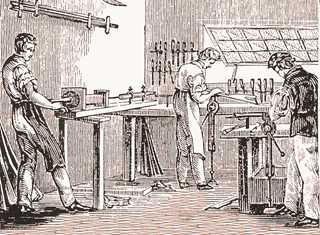
In 1828, Eliphalet successfully moved his growing barrel operation from Ilion Gulch to what would later become Ilion, New York. In the late 1840s, Eliphalet began making carbines and rifles for the U.S. Government, entering the arms making business in which they became world famous. With the entry of his three sons, the business became known as E. Remington & Sons, making hundreds of thousands of pistols, rifles and muskets for the Federal Army during the Civil War. In 1871, the company began making centerfire pistol and rifle ammunition, and brass shotshells. As the company expanded, they manufactured agricultural implements, bridges, fire engines, steam-powered street cars, typewriters and sewing machines.
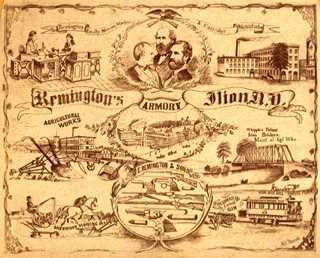
In 1888, this vast business was acquired by Schuyler, Hartley & Graham and others. Marcellus Hartley, a principal in the company, also owned one of the largest ammunition companies in the world - the Union Metallic Cartridge Company. In 1911, both Remington and UMC were combined.
The early 1900s marked the beginnings of a nationwide initiative toward waterfowl conservation. The age of market hunting and "plume collecting" had resulted in serious declines in wildfowl populations and legislation, much of it spearheaded by forward-thinking hunters, served to protect duck and goose populations and habitat. The Lacey Act was passed in 1900 and hunters took to the field to feed their families and for sport, rather than to make a living from selling wild game.
Until that time Remington's shotgun line consisted primarily of side-by-side shotguns, most notably the Model 1900, which was a basic box-lock action that was designed for use with paper or brass shells and was an unadorned field gun with steel or Damascus barrels. The hammerless design was a favorite of sport and market hunters alike.

The 1900 side-by-side was discontinued in 1910, when Remington launched their first successful repeating shotgun, the pump-action Model 10, designed by John Pedersen.
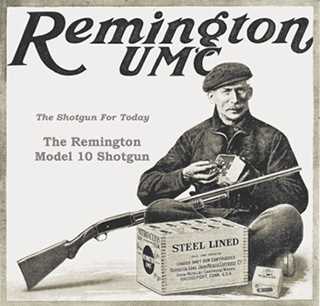
This bottom loading and ejecting pump, the Model 10, was primarily known as a service weapon, and some were used during World War I, but the design would also be popular with hunters.
Concurrently with the Model 10, the company launched the Model 11, a John Moses Browning-designed autoloader. Most of Browning's early designs had been manufactured by Winchester, but when he and the company could not reach an agreement regarding royalties, Browning took his design to Remington, and they quickly secured the rights to the firearm.
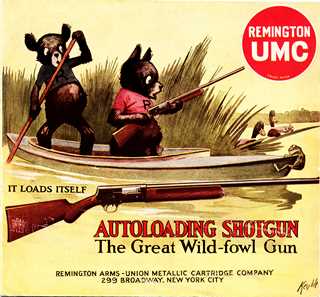
The Model 11 used a short recoil operating system and a tubular magazine, but its most striking design feature was a squared-off receiver that closely resembled the gun that Browning himself would later market as the A5. The original "humpback" design, so closely associated with Browning's namesake company, actually debuted on a Remington firearm. The Model 11 became one of the early 20th century's premier semiautomatic firearms, and one utilized widely by waterfowl hunters.
The Model 11 was not the last gun that Browning designed for Remington. In 1915, he developed a prototype of a bottom feeding and ejecting pump-action shotgun that was to be the successor to the Model 10.
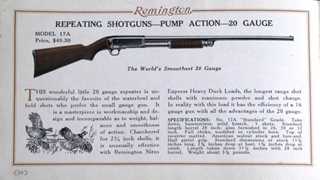
Known as the Model 17, this slide-action shotgun was presented to Remington by Browning and later altered by Pedersen. This gun went into production in 1921, following World War I. The new design was light (the 20 gauge was only 5 frac34; pounds), and the Model 17 would influence later shotgun designs, most notably the Ithaca Model 37 and Browning's BPS. In 1929, John Pedersen again reinvented the Remington pump shotgun with the introduction of the Model 29, another bottom feeding and ejecting shotgun that had durable coil springs and was available with 26, 28, 30 and 32 inch barrels with fixed cylinder, modified or full barrel.
The Model 17 was followed shortly thereafter by another Pedersen-designed shotgun, the Model 31, which was Remington's very first side-ejecting pump shotgun.

Remington's first over/under followed shortly thereafter. The Model 32 was designed by Remington engineer Crawford Loomis and was the brand's answer to Remington's competitor's Superposed designs. It was an American-made shotgun and the initial price of these guns was about $30 less than the basic Belgian-made Superposed. The Model 32's initial development began during the Great Depression, but its release in 1932 was well-timed; as the American financial landscape began to level out, shotgun sports, particularly skeet, were growing in popularity, as were acceptance of over/under guns.
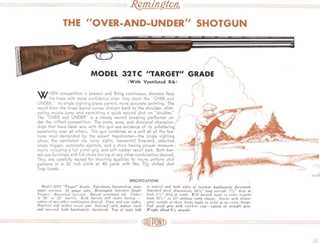
The Model 32 incorporated a very solid locking mechanism that revolutionized over/under design and promised exceptional longevity. Additionally, the gap between the top and bottom barrels afforded faster cooling between shots and helped reduce weight even with heavier steel barrels. The 32's run was cut short by the start of the Second World War; in 1934 Remington became Remington UMC and ammunition production superseded the manufacture of field guns.
Following World War II, after Remington UMC's commitment to providing ammunition for the government ended, a new semiautomatic shotgun was developed. Known as the 11-48, this new gun was the successor to the Model 11 and became one of Remington's most popular designs for waterfowl hunters of that era.

The 11-48 had a long-recoil system, so the barrel and bolt both move rearward under recoil to cycle the action. The operating system proved very reliable and functioned well under the most extreme conditions, but the 11-48 ushered in a new manufacturing element that has remained part of Remington designs ever since. The 11-48 incorporated stamped steel parts, which were more affordable than forged steel and were interchangeable with other parts. There were two recoil springs in the 11-48-one in the buttstock that returned the bolt to battery and one over the magazine tube that returned to barrel in proper position for follow-up shots.
Just after the launch of the 11-48, Remington engineers developed the Model 870, a shotgun that set a new standard for pump-gun function and reliability. It featured a side-ejection design, affordable stamped parts, a steel receiver, dual-action bars, and a bolt that locked into a recess in the barrel. The sleek design was immediately accepted and became a perennial favorite for waterfowlers. Since its initial release in 1951, the Model 870 has gone on to become the most popular shotgun of all time, with more than 10 million produced to date. Over the course of its long life the 870 has been available in 12, 16, 20, and 28 gauges as well as .410 bore in a variety of offerings for military, personal defense, competition, and hunting applications. It remains one of the most popular, if not the most popular, waterfowl shotgun designs of the twentieth century.

In 1963 a Remington semiauto design that had been in development for three years broke cover. Known as the Model 1100, it was a follow-up to the brand's successful Model 11-48, and Model 58 shotguns. It relied on a more streamlined and reliable gas-operating system than previous models. The gasses from the fired shell bled through port holes in the barrel and that energy was used to drive a steel sleeve around the magazine tube rearward, operating the action.

Unlike its predecessors, the 1100 was light and functioned very well, and it became a staple of the Remington line. The gas operating system, once considered rather radical, suddenly had great appeal. One of the benefits of gas operation was an extended recoil delivery, which made the 1100 a very soft-shooting gun. It would become the standard by which other semiautos of that era were judged. The 1100 remains in production today, and although it has faced competition from newer designs it remains one of America's favorite hunting arms.
In 1984, DuPont, which had purchased a controlling share of stock in the company in 1933 and then the remaining shares in 1980, decided to move Remington's headquarters from Bridgeport, Connecticut, to Wilmington, Delaware, though firearms production continued at the historic Ilion facility. Three years later the company updated the 1100 design with the addition of the 11-87. The primary difference between the two guns were that the 1100 required a barrel swap when switching between 2 3/4- and 3-inch shells and the 11-87 did not, though the operating system remained largely the same.

In addition, interchangeable Rem Chokes, first offered in 1986, made the 11-87 even more versatile. In 1989 the company launched its first gas-operated 10 gauge shotgun, the SP-10, which became a favorite of goose hunters.
The introduction of 3 1/2-inch shells to the waterfowling community prompted the company to launch the Model 870 Super Mag 3 1/2 in 1998, and two years later a Super Mag 11-87 appeared.


Something else important occurred at Remington in the 1990s; DuPont, which had been the primary shareholder of the company since 1933, sold Remington's assets to RACI Acquisitions. Three years later Remington headquarters moved to Madison, North Carolina.
In 2006, the same year the Model 1100 G3 was released, which had a 2 3/4- and 3-inch chamber, the company also released the Remington Premier over/under. In 2007, the Premier side-by-side was launched, the first side-by-side since the Model 1900 was dropped from the Remington catalog 97 years earlier.

In 2009 Remington announced the release of a brand-new pump shotgun that was of special interest to waterfowlers. Known as the Model 887 Nitro mag, it featured an ArmorLokt polymer finish coating, which made the gun impervious to the elements. It did indeed have an armored look, and it was priced affordably. Duck and goose hunters, known for being particularly hard on finishes, took notice, particularly those who hunted in and around salt water, which is notoriously corrosive. The 887 won over its share of fans, but it was dropped from production in 2015.

The first brand-new Remington semiauto since the 1100/11-87 to win the favor of waterfowl hunters was the Versa Max. Introduced in 2010, the Versa Max utilized a unique gas-operating system unlike any other on the market.

Instead of the traditional gas bleeding design of earlier guns, it relied on what Remington dubbed the Versa Port system, which consists of a series of vent holes that are blocked or left open based on the length of the shell used. In 2015, the brand followed up with its latest shotgun, the V3, a 3-inch semiauto that functions with a modified Versa Port system and has dual return springs mounted in the receiver for proper balance and ease of maintenance.

Remington's 200 years in business is an important milestone in American firearms manufacturing. The company has been providing duck and goose hunters with the guns they need to succeed in the field for generations, and the company's current lineup includes popular, time-tested designs like the 1100, 870 and 11-87 as well as relatively new guns like the Versa Max and V3. And, like other Remington guns before them, these new models are built in America and designed to last over years of service. Big Green remains true to their red, white, and blue roots, and waterfowlers of the past, present, and future will have stories to tell and hunts to remember thanks to this storied company.
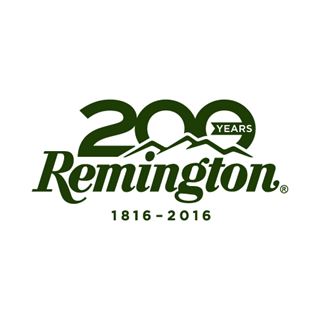
Ducks Unlimited uses cookies to enhance your browsing experience, optimize site functionality, analyze traffic, and deliver personalized advertising through third parties. By continuing to use this site, you agree to our use of cookies. View Privacy Policy